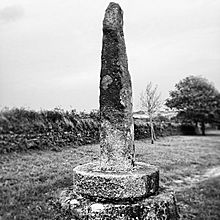|
|
|
|
The Tristan LongstoneStanding Stone / Menhir
|
|
|
|
Images (click to view fullsize) |
|









|
Fieldnotes |
|
|
Visited 18.4.12 Whilst on my way to Fowey to visit St Catherine’s Castle (another E.H. site off the list!) I took the opportunity to have a look at the Tristan Stone. Very easy to see spot as it is right on the B3415. **As an aside, in order to visit the castle you have to cross a lovely little beach / cove below the castle. This would make a great place for a day at the beach in nice weather. I found a set of car keys on my return trip and had to wait for nearly an hour for the worried owner to return to the beach to reclaim them. He was happy – so was Dafydd – he had extra ‘play time’ on the beach! |
Posted by CARL 3rd May 2012ce |
Folklore |
|
|
Carew entertainingly wrote in his 1602 Survey of Cornwall: ".. a gentleman, dwelling not far off, was persuaded.. that treasure lay hidden under this stone: wherefore, in a fair moonshine night, thither with certain good fellows he hieth to dig it up.. a pot of gold is the least of their expectation: but... in the midst of their toiling, the sky gathereth clouds, the moonlight is overcast with darkness, down falls a mighty shower, up riseth a blustering tempest, the thunder cracketh, the lightning flasheth: in conclusion, our money seekers washed, instead of laden.. and more afraid than hurt, are forced to abandon their enterprise, and seek shelter of the next house they could get into." Another example of the bad weather and trouble you can expect if you mess with the monuments of our ancient forefathers. at http://www.gutenberg.org/dirs/etext06/srvcr10.txt (scroll down to 137) * * * Daphne du Maurier lived near where the Tristan stone stood before it was moved (crossroads at sx1051), and she wrote her own version of the Tristan and Iseult story, with which it has legendary connections (see also Castle Dor.) |
 Posted by Rhiannon
Posted by Rhiannon7th April 2004ce Edited 16th July 2006ce |
Miscellaneous |
|
|
In Wm Borlase's Antiquities of the County of Cornwall, pub. 1769, the inscription is read thus: CIRVSIVS HIC IACIT CUNOWORI FILIVS The reading of the first name as DRVSTANVS seems to be generally accepted at present, with the initial letter(s) construed as a 'D' written back-to-front. I have never yet been able to find the evidence upon which such a reading is based: for example, other inscriptions from (around) the same period in which a 'D' is written back-to front. Do such examples exist? If so, where? |
Posted by TonySnell 6th September 2005ce |
| In a recent edition of Making History on Radio 4, Dr Oliver Padel described the Tristan Stone as a possible converted standing stone. Apparently the inscription on the stone is similar to other 6th Century inscriptions in Cornwall and Wales. He was relatively happy to entertain a connection between the stone and the Tristan of legend, but emphasised that there was no definite link between the stone and the story. Nothing surprising there I guess. |
 Posted by Kammer
Posted by Kammer7th May 2004ce |
| Craig Weatherhill’s ‘Cornovia: Ancient Sites of Cornwall and Scilly’ (1985, revised 1997 & 2000) gives this info – “This great pillar stone, 2.7m high and set on a modern plinth, was formerly called the long stone. Originally it stood closer to Castle Dore, 2 miles to the North. High on the back of the stone is a Tau cross, carved in relief; on the front, running vertically down the stone, is a two line inscription interpreted as ‘Drustanus Hic Lacit Cunomori Filius’ (Drustanus lies here, son of Cunomorus). This has been dated to the sixth century AD. The two names have been equated with the famous Tristan and King Mark of Cornwall; indeed, a ninth century manuscript speaks of ‘Marcus, also named Qunonomorius’ who ruled over both the British and Breton regions of Dumnonia and Domnoneee. Unfortunately, the first name of the inscription is now almost ineligible” |
 Posted by pure joy
Posted by pure joy26th March 2003ce |
|
Beside the road leading to Fowey in Cornwall stands an ancient, weathered stone measuring some 7 feet in height and set in a millstone base. It was once much closer to Castle Dore and may have been the origin of the association of this site with the story of the tragic love of Tristan and Iseult. There is a Latin inscription on the stone, now much worn, which can be restored with only a little judicial guesswork to read: Drustans hic iacet Cunomori filiusThis means, "Drustanus lies here, the son of Cunomorus". It has been suggested, plausibly, that the characters referred to are Tristan, the nephew of Mark - Drustan being a recognized variant of the hero's name and Cunomorus being a Latinization of Cynvawr. |
Posted by phil 30th November 2001ce Edited 24th March 2013ce |
Links |
|
Making HistoryRadio 4 programme Making History. The Tristan Stone - is it the Tristan who loved Isolde? Listener's query: "I live in Fowey, Cornwall, and outside of Fowey there is a monolith with the legend 'Here lies Tristan son of King Mark'. Is the Tristan on the stone monolith the Tristan of the Tristan and Iseult story?":Brief summary: The Tristan Stone, near Fowey in Cornwall, is a weathered monolith about 9 feet high like a Neolithic standing stone. It might even be a Neolithic stone, but it has a worn inscription on it: Drustans hic iacet Cunomori filius, which means "Here lies Drustanus, the son of Cunomorus".Continues... |
Posted by phil 16th January 2005ce Edited 17th January 2005ce |
King Arthur's KnightsA good photo and guide. |
Posted by phil 27th January 2002ce Edited 7th May 2004ce |

